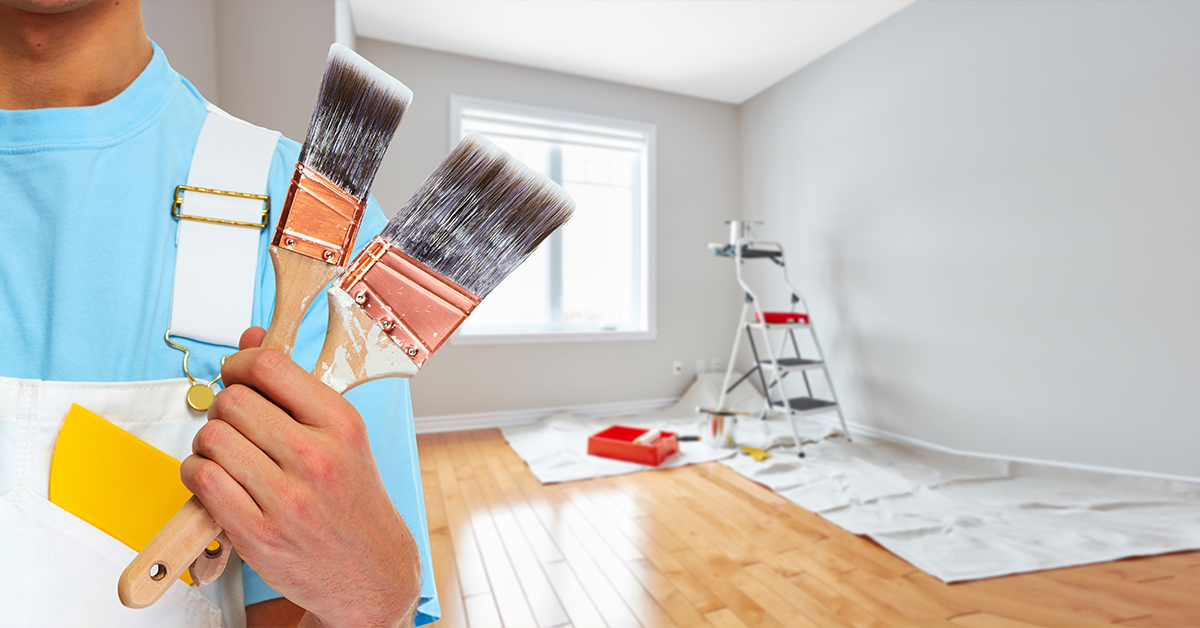
Introduction
How do you choose the best paint brushes for the job? When it comes to painting your home, the choice of brushes can make all the difference. Paintbrushes are the unsung heroes of house painting, influencing the finish quality, precision, and ease of the task at hand.
Keep in mind, that the brush that you select will depend on the type of paint you select. See this article on choosing the right paint.
In this guide, we’ll explore the world of paintbrushes for interior and exterior house painting. We’ll discuss the various brush types, the difference between synthetic and natural bristles, and the importance of bristle stiffness. Whether you’re a seasoned DIY enthusiast or a professional, this guide will help you make informed decisions and achieve outstanding results in your painting projects. So, let’s dive in and discover the best paint brushes that will transform your home.
Types of Brushes
Flat Brushes
Flat paint brushes are versatile tools designed for efficiently covering large, flat surfaces. They excel in providing smooth, even paint application on walls, ceilings, doors, and other sizable areas. These brushes are known for their ability to create uniform finishes and are particularly useful for both interior and exterior house painting projects. Depending on the type of bristle material, they can be suitable for water-based paints, making them a valuable addition to any painter’s toolkit. The flat brush is one of the best paint brushes for large applications.
- Bristle Type: Synthetic or Natural
- Purpose: Ideal for large, flat surfaces like walls and ceilings.
Angled Brushes
The best paint brushes I own are my angled paint brushes, with their slanted bristle arrangement, are essential tools in the world of painting. These brushes serve a crucial purpose, offering precision and control in applications where clean edges and corners matter. Their design allows for accurate cutting-in and detailing, making them ideal for creating sharp lines and crisp borders.
Angled paint brushes are often the choice for intricate work, such as painting trim, molding, or any surface where precision is required. They excel at reaching tight spaces and ensuring a professional finish in both interior and exterior painting projects. These brushes are a must-have for any painter seeking accuracy and fine craftsmanship in their work.
- Bristle Type: Synthetic or natural
- Purpose: Perfect for cutting-in along edges and corners.
Round Brushes
Round paint brushes, characterized by their circular bristle arrangement, serve a distinct purpose in the realm of painting. These brushes are prized for their versatility and suitability for detailed work. Their rounded shape allows for precise control, making them ideal for creating curves, intricate designs, and fine details on various surfaces.
Round brushes are commonly used for artistic and decorative painting, as well as for highlighting and accentuating features in interior and exterior projects. They excel at holding and distributing paint evenly, enabling artists and painters to achieve intricate, professional results. Whether you’re working on a canvas, furniture, or any surface requiring meticulous detailing, round paint brushes can be the best paint brushes for achieving the desired level of finesse and precision in your work.
- Bristle Type: Synthetic or natural
- Purpose: Suitable for detailed work and curves.
Trim Brushes
Trim paint brushes play a vital role in the world of painting, with a distinct purpose centered around precision and finesse. These brushes are specially designed for tackling trim work, molding, and other smaller areas that require meticulous attention. Their narrow and tapered bristle arrangement allows for impeccable control, making it easier to achieve sharp edges, clean lines, and intricate detailing. Trim brushes are essential tools for both interior and exterior projects, where accuracy is paramount. They excel at reaching tight spaces and ensuring a professional finish, making them the go-to choice for any painter seeking to enhance the aesthetics and craftsmanship of their work, particularly when dealing with trim and delicate features.
- Bristle Type: Synthetic or natural
- Purpose: Designed for trim work and smaller areas.
Check out Purdy for a nice selection of quality paint brushes.
Bristle Types
Explain the pros and cons of synthetic and natural bristle brushes.
Synthetic Paint Bristles
- Pros:
- Durable and long-lasting.
- Excellent for water-based paints.
- Easier to clean.
- Less prone to shedding bristles.
- Often more affordable.
- Cons:
- May not hold as much paint.
- Limited suitability for oil-based paints.
- Less natural feel in some cases.
Natural Paint Bristles
- Pros:
- Great for oil-based paints.
- Hold more paint, reducing the need for frequent dipping.
- Provide a smooth, even finish.
- Offer a traditional, tactile painting experience.
- Cons:
- More expensive.
- Prone to shedding bristles.
- Require more careful cleaning.
- Not as durable as synthetic brushes in the long term.
Stiffness Varieties
Explore the variety of bristle stiffness and their purposes.
- Soft Bristle
- Precise Painting: Soft bristle brushes provide smooth and even paint application.
- Smooth Finish: They eliminate brushstrokes for a polished look.
- Suitable for Delicate Surfaces: Gentle on fragile materials like woodwork and furniture.
- Versatile in Material Compatibility: Works with various types of paint.
- Easy Cleanup: Simple maintenance and reusability.
- Detail Work: Ideal for small touch-ups and intricate designs.
- DIY Home Improvement: A staple for home improvement projects.
- Crafting and Art Projects: Popular among artists and crafters for controlled strokes.
- Medium Bristles
- Versatile: Suitable for a wide range of painting tasks.
- Effective Paint Pickup: Holds paint well for consistent coverage.
- Balanced Finish: Offers a balance between precision and coverage.
- Ideal for Walls: Great for painting walls, especially larger surfaces.
- All-Purpose Use: Can handle various paint types, including latex and oil-based.
- Moderate Detail Work: Suitable for moderate detail and trim work.
- Easy to Clean: Relatively easy maintenance for multiple uses.
- Firm Bristles
- Heavy-Duty Painting: Suited for tough and demanding painting jobs.
- Strong Paint Pickup: Excellent for applying thick or heavy coatings.
- Smooth and Controlled Application: Provides control for even, precise strokes.
- Ideal for Rough Surfaces: Works well on textured or uneven surfaces.
- Compatible with Oil-Based Paints: Particularly effective with oil-based paints and coatings.
- Heavy Detail Work: Suitable for intricate detail work and trim.
- Durable and Long-Lasting: Designed to withstand heavy use and extended projects.
- Requires Thorough Cleaning: Due to the heavy-duty nature, thorough cleaning is essential for longevity.
- Instead of using tape to help with painting straight lines (tape by itself is not perfect at stopping paint seepage), try using a stiff, angled brush and a steady hand. Angled brushes are the best paint brushes to use for this.
- It will take some practice, but the payoff is great!
Purpose-Based Selection (Best Paint Brushes For Interior vs. Exterior)
There aren’t any hard rules on what type of brush to use on the exterior vs. interior. But the following information may provide some direction when choosing the best paint brushes.
- Best Interior Paint Brush: For interior painting, consider using a high-quality synthetic bristle brush. These brushes offer several advantages:
- Smooth Finish: Synthetic brushes are excellent for achieving a smooth and even finish on interior walls, ceilings, and trim.
- Easy Cleanup: They are easier to clean compared to natural bristle brushes, making them convenient for indoor projects.
- Versatile: Synthetic brushes work well with both water-based and latex paints, which are commonly used for interior surfaces.
- Durability: A good synthetic brush can last through multiple interior painting projects if properly cared for.
- Reduced Shedding: Synthetic brushes are less prone to shedding bristles, ensuring a neater and cleaner painting process indoors.
- Best Exterior Paint Brush: When tackling exterior painting projects, opt for a high-quality natural bristle brush, specifically one made from China bristle (hog hair) or a blend of natural and synthetic bristles. Here’s why:
- Hold More Paint: Natural bristle brushes can hold a larger amount of paint, reducing the need for frequent dipping and ensuring efficient coverage on exterior surfaces.
- Ideal for Oil-Based Paints: Many exterior paints are oil-based, and natural bristle brushes are well-suited for these formulations.
- Smooth Application: They provide a smooth and even application, which is essential for exterior walls, trim, and other surfaces.
- Traditional Finish: Natural bristle brushes offer a traditional and tactile painting experience, which some professionals prefer for exterior work.
- Careful Cleaning: While natural bristle brushes require more careful cleaning, their performance on exterior surfaces justifies the effort.
Other Features to Consider
When selecting a paint brush you want to purchase the best paint brushes for the job. Several key factors should be kept in mind to ensure a successful and efficient painting project.
First, consider the handle design, as it significantly affects your comfort and control during painting. Choose a handle that feels comfortable in your hand and provides a secure grip, reducing fatigue during long painting sessions.
Next, pay attention to the size and width of the brush. Larger brushes are ideal for covering large areas quickly, while smaller ones excel at detail work. Select a brush size that suits the specific surfaces and tasks you’ll be working on.
Additionally, cleaning and maintenance are crucial for prolonging the brush’s lifespan. Always clean your brush thoroughly after each use to prevent paint buildup and bristle damage.
Lastly, budget considerations are important. While high-quality brushes can be an investment, they often yield better results and last longer, ultimately saving you time and money in the long run. Strike a balance between quality and budget to ensure a successful painting experience.

